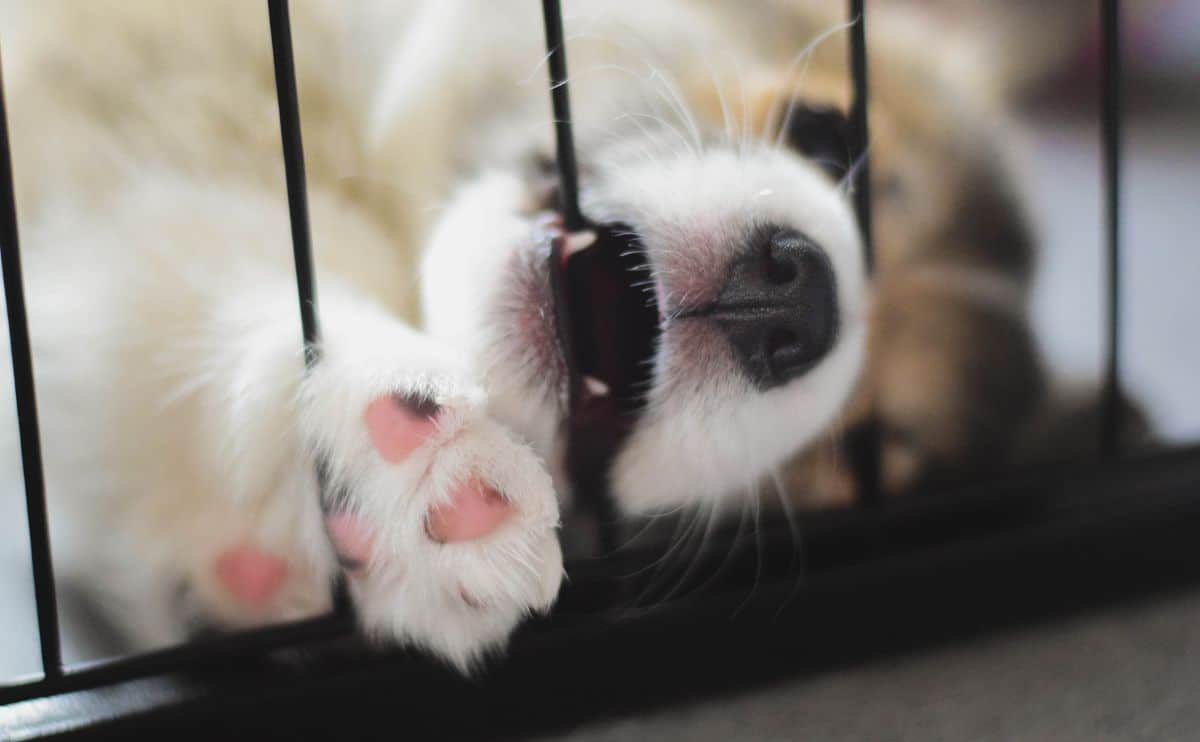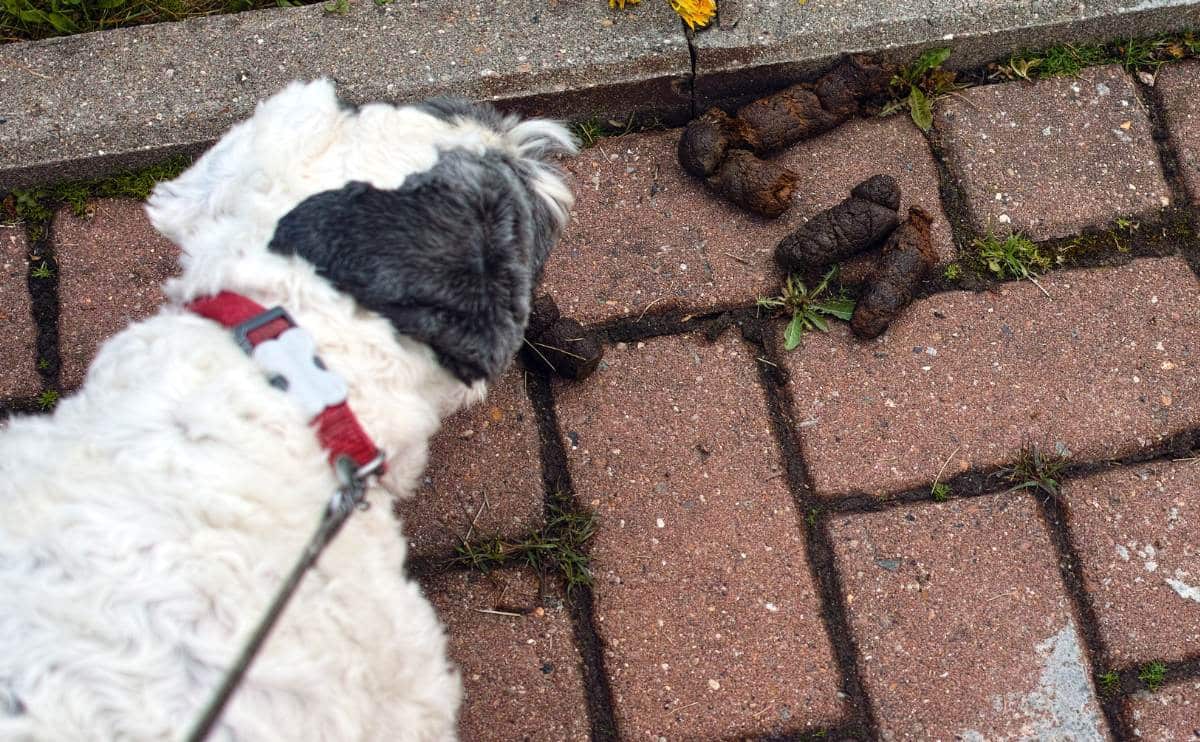When you purchase through links on our site, we may earn a commission. Here’s how it works.

Is the joy of your new family member wearing thin because your puppy won’t stop crying and whining in his crate? His crate is supposed to be his happy place, and nothing is more frustrating than when it’s a torture chamber instead. The good news is, there’s a lot you can do to nip the crate whining in the bud so it doesn’t become a prolonged problem. These puppy crying in crate tips can help stop your puppy from crying in his crate so you’ll both sleep at night.
Table of Contents
Will Your Puppy Ever Like His Crate?
Is your puppy screaming in his crate for hours? With patience and practice, your dog should eventually “cave” in and learn to love his crate. However, it’s best if you ease him into it properly. Dogs are instinctively denning animals, and they find comfort in having a pad of their own.
Puppies cry in crates for many reasons. Often they are scared, bored, lonely, or anxious. Puppies are not used to being confined to a small space, and they may be confused. Whining and crying is their way of expressing that they are unhappy with the situation.
But first, puppies need assurance that their new crate is a safe, inviting place — not a cage that serves as a long-term babysitter or a tool for punishment (it’s not a time-out chair). Easier said than done, right?
Crate Training Basics
If you take the lead and follow the steps in our crate training article, it can be relatively painless. The earlier you start crate training, the better. This guide walks you through the basics, including recommended crates to use. If you’ve read that article, tried those tactics, and still have trouble with whining, then read on for some additional tips.
Why Is Your Puppy Still Whining?
So, you followed the initial crate training steps, but your dog is still whining. It could be that you rushed the process. Try again more gradually. If your dog continues to cry, don’t go to him or pay attention to him. It might be tempting to try and relieve your puppy from his discomfort after a few minutes — don’t do it. Puppies soon learn that whining will get your attention, and you’ve got a significant problem. While it may stop whining momentarily, you are teaching your pup this is a way to get what he wants.
Author and Dog Expert Arden Moore says, “You need to break the whine cycle just like parents must do with fussy toddlers by ignoring them when they are whining for whining’s sake.” She adds, “Once your dog learns that whining gets her no attention from you, she will realize that being quiet reaps the best rewards.” You can read more of her tips in The Dog Behavior Answer Book.
It’s not only okay for your puppy to be in his crate alone, but it’s also beneficial for future behavior and temperament — it fosters independence. It helps stave off later issues with separation anxiety. With that said, you mustn’t overuse the crate or make it a place of punishment.
How Long To Let Your Puppy Cry In His Crate
If you do have to crate your puppy more than you’d like (long workday, tons of errands to run, etc.), make sure you spend extra time playing with him or taking him on walks in between crate times. And don’t forget that a puppy’s bladder can’t go for long periods of time without relief — no more than a few hours at a time at first.
Important Note
According to the Animal Humane Society, leaving a puppy in a crate for an 8-10 hour workday is “not an appropriate way” to crate train. If you have times when you can’t be there, ask a neighbor or hire a pet sitter to give your pup a break. The more attention they have while outside of the crate, the less time they spend whining and crying once back in the crate.
Get Pet Insurance Quotes Instantly
Puppy Won’t Stop Crying In Crate At Night
You don’t have to lose sleep over your puppy crying in his crate at night. First, you need to make sure you’ve taken care of his needs before bedtime.
Is Your Puppy Tired?
Puppies have a lot of energy (as you well know!), and they need to work it out before going into their crate at night. Take your dog on a long walk and play with him before bed so it burns off that energy.
Does Your Puppy Need To Relieve Himself?
Bathroom breaks are critical, especially for puppies whose bladders can’t last long. Make sure your puppy does all his business outside as close to bedtime as possible. Don’t worry — the older your pup gets, the longer he’ll go without needing to go potty.
How To Get A Puppy Used To A Crate
If your puppy cries in his crate before bed (or anytime):
- Make sure you place good bedding and a few favorite toys in the crate.
- It’s also essential to consider the room temperature. Puppies and smaller dog breeds can get chilly quickly, so make sure you position the crate in an area that’s not too cold (or too hot).
- If the crate is too large, your dog could feel intimidated, so be sure to select the best crate for your dog’s size.
If you’ve done all you can to satisfy your pup’s basic needs, consider putting him to bed with a chewable treat or super strong toy. This will distract your puppy and hopefully wear him out until he nods off.
Should You Close A Puppy Crate At Night?
You should keep the crate door closed at night for at least the first few months. This will eliminate any confusion and ensure your puppy doesn’t try to sneak out, especially when you’re asleep. Even if your puppy is crying in the crate at night, keep the door closed until you have fully crate-trained him. It may be loud, but you must establish this boundary now while he is young.
When To Move The Puppy Crate Out Of Your Bedroom
When your puppy stops whining in his crate, you can slowly start to transition him to another room. Start by moving the crate closer to the door. Then eventually, the permanent place in the home.
What If My Puppy Won’t Stop Barking In His Crate?
If your puppy is still crying at night after 3 weeks or so, try placing a blanket over his crate for comfort. You might also have some larger issues outside the crate training itself. Dogs need to know that you’re in charge. If they don’t trust you, they won’t behave well no matter how hard you try. Once your puppy earns your respect, then he’ll realize that you’re putting him in his crate for his own good.
And remember, resist all temptation to go to the crate. If you acknowledge your puppy’s whining with attention, he’ll learn that all he has to do is cry, and you’ll be there. As challenging as it might be, let your dog settle himself down. After a few nights, he should understand that whining and crying in the crate won’t get him anywhere. Get some earplugs (or use a white noise app on your phone) and know it’s a short-term sacrifice for long-term happiness for you and your pup.
Personal Experience With My Puppy Crying In The Crate
My Poogle (Poodle Beagle Mix) Falkor is about two and a half years old. I crate-trained him from day one, but it was not an easy or quiet process. He was particularly unhappy being left in the crate when no one was home. We have a big house, with multiple floors, as well as other animals. It is not safe to leave him out at night, or when we are gone, so crate-training was a must.
It took almost 3 months to get Falkor to quiet down in his crate during puppy training. Even now, he still whines and cries if we are leaving or if he doesn’t want to be in the crate. However, if he whines and cries when we are home, he has to stay in his crate longer until he pipes down. While the major temper tantrums and crying are no longer happening, I still do not give in to any whining, as I know it will undo all the hard work we have done to get him comfortable in the crate.
–Danielle DeGroot, Poogle parent
Have you had experience with a puppy crying in a crate? We would love to hear how helped your pup through it in the comments.
Don’t Say No To The Crate
We couldn’t resist sharing this funny video of what can happen if your dog resists his crate. You don’t want an ongoing battle with your pup.
Remember Why You’re Doing The Tough Training
It’s not easy housebreaking puppies — remember, they’re in a new place, away from their mom and litter. When you’re working on how to get your puppy to stop crying in his crate, try to remember that this is an all-new environment, and your puppy needs time and reassurance to adjust.
As time-consuming and frustrating as crate training (and other puppy behavior problems) might be at first, your hard work will surely pay off in the long run. And if you still find yourself struggling, you might look into professional training (especially while your dog is young). We recommend an online dog training program like Doggy Dan’s online course or a local dog trainer.
Remember: keep your eye on the prize. Your end goal is for your puppy to want to be in his crate.



